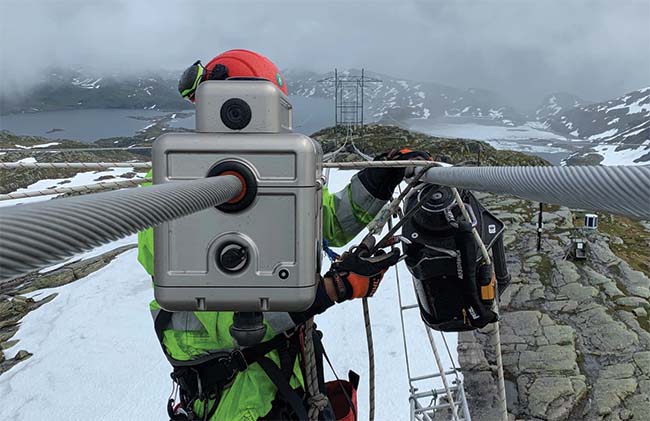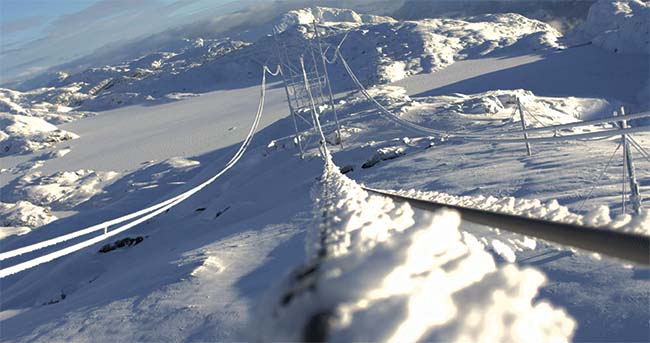Upgrades to Line Sensors Support Reliability of the Power Grid

New technologies to monitor power lines are emerging worldwide, part of continuing efforts to harden the power grid and increase reliability and resiliency. Utilities and other operators of electricity transmission and distribution (T&D) systems have made T&D upgrades a priority as power outages become more frequent due to an increase in the number of extreme weather events across the world.
Today's monitoring technology features wireless power line sensors, cameras, and faulted circuit indicators that may use advanced detection algorithms to sense problems on overhead lines in real time. These systems also are moving beyond the traditional methods of using fossil fuel-powered generators, batteries, or even wind turbines or solar panels to provide the power needed for their operation. Instead, they are adopting self-harvesting" technology, drawing operating power directly from the power line.
These systems can do more than sense faults. They also may serve as eyes in the sky" in more remote areas, using cameras to discover issues long before a maintenance worker would be able in the arrive in the vicinity. These systems can alert utilities and line operators to things such as wildfires, enabling faster deployment of wildland firefighters. They can spot conditions that could lead to icing on power cables, or provide visual confirmation of damage or other problems along the line.
Several utilities are taking advantage of new overhead power line sensor solutions, both in the U.S., Canada, and elsewhere. Minnesota-based Xcel Energy last year hired LineVision to deploy that company's technology across transmission lines in part of the utility's territory in Minnesota, Colorado, and Wisconsin. The project is a collaboration that includes Oak Ridge National Lab, with data collected from the project being analyzed in a study on advanced line ratings.
The technology can help alleviate congestion on power lines, and enable additional power capacity on those lines, which in Xcel's case could help the utility add more renewable energy to the grid as part of the utility's 100% carbon-free electricity by 2050 goal. Xcel, like other utilities that serve areas of the drought-stricken western U.S., also is using sensors to identify areas of potential wildfire risk, along with determining when line maintenance is needed to alleviate grid stress and help suppress power outages.
New technologies have been developed to reduce the maintenance required of the sensor systems, with those systems themselves hardened to better withstand extreme weather and other challenging operating conditions. Several companies, including Ampacimon (Belgium), Heimdall Power (Norway), Gridpulse (Slovenia), Sentient Energy (California), and more are deploying new technologies to enhance grid safety and reliability, including those sensors that operate on power harvested" from the power line itself.
 |
1. Osvaldur Knudsen, CEO of Laki Power, and Bjorn Sighvatsson, the company's head of manufacturing, talk about the company's power line monitoring equipment during a meeting with U.S. media members, including POWER, in mid-June. Courtesy: Sigurjon Ragnar |
One example of this self-powering technology has been developed by Laki Power, a company based in Iceland that was named Innovation Company of the Year" in 2021 by Samorka, the federation of energy and utility companies in Iceland. Osvaldur Knudsen, Laki Power's CEO, told POWER during a recent meeting (Figure 1) at the company's Reyjkavik headquarters that the company's products feature Laki's PowerGRAB electromagnetic energy harvesting technology, a system of springs, magnets, and coils, where the magnet and the coil move relative to each other. This movement creates a change in the magnetic flux that produces an electromagnetic force.
Knudsen said the technology uses a cold" power regulation technique to capture high-voltage powerline current as a usable low-voltage DC output, which he characterized as having as much as 100 times greater efficiency than other on-market monitoring solutions. It could in practice enable a range of energy-intensive peripheral systems, he said.
Knudsen noted several attributes of Laki Power's system, telling POWER, I just think more than anything that we can cut down on maintenance by offering a robust system that is completely self-sufficient and therefore much more economical." Knudsen said there is added complexity and costs associated with external power sources-solar panels get covered in snow and dust, wind is intermittent, diesel generators are expensive and need fossil fuel, and fuel cells can be expensive and need maintenance." He said that while a Laki Power monitoring station could potentially be significantly cheaper that solutions relying on external power, I will say that our goal is not necessarily to be the cheapest solution, but the best one."
Knudsen said PowerGRAB is not affected by fluctuations in the phase wire current flow, making it well-suited for sensitive surveillance and measurement devices. It can provide real-time environmental monitoring and thermal event detection to help spot wildfires, a build-up of ice on power lines, and also provide information about dynamic line rating. The technology is part of Laki's LKX MULTI system, which is essentially the monitoring station we've used in our pilots with improvements, an improvement on the LKX-201," said Knudsen, noting it's best used to determine icing, vibration and galloping, salinity measurements, and sag/ground-clearance calculations."
 |
2. A worker installs a Laki Power monitoring station on a power transmission line on top of Alvik mountain in Norway. The line is 1,000 meters, or 3,280 feet, above sea level. Courtesy: Laki Power |
The system has been deployed in Iceland with Landsnet, the country's transmission system operator. Iceland has a problem with a build-up of ice on the power lines, as does Norway-where Statnett, that country's transmission line operator, in 2020 installed a Laki Power monitoring station 1,000 meters (3,280 feet) above sea level on Alvik mountain to monitor icing on power lines in the remote location (Figure 2). The area is highly exposed to foul weather blowing in off the fjord, which creates perfect conditions for ice accumulation (Figure 3) on towers, shield wires, and phase conductors. Statnett has traditionally used two methods to remove ice: flying a helicopter to a site to knock ice off the line with a wooden pole or heating the power lines with increased current, which has been the preferred method. But either method only works well if the line has a small amount of ice, so an early warning of ice build-up is needed.
 |
3. A view of ice on the power lines and snow on Alvik mountain in Norway, taken with a Laki Power monitoring device. Courtesy: Laki Power |
Statnett had monitoring devices for its lines, but it needed to use external power sources like diesel generators and solar power. The group recognized the benefits of a self-powered sensor system such as Laki's. Being able to utilize the conductor current to power the monitoring devices is a huge benefit," said Miroslav Radojcic, project manager at Statnett. It reduces costs and provides us with accurate data and a unique viewpoint since the Laki Power station is on the conductor itself."
Laki Power also has worked with Manitoba Hydro, a group that began testing line sensors in 2006, and over the years has used a variety of technologies with varied success in an often-harsh environment of northern Canada. Manitoba Hydro and Laki Power began a pilot project earlier this year, part of Manitoba Hydro's effort to effectively monitor and respond to icing and other weather events on the company's transmission lines. Knudsen told POWER, We just finished two installations with Manitoba Hydro on live lines ... [and] that's a huge win for us."
Knudsen also noted the deployment of his company's technology in Greece, begun in May of this year in partnership with ipto, the country's independent power transmission operator. Laki is using its LKX SURV model, which relies on a camera and sensors to help detect excessive heat, or evidence of a wildfire. Knudsen said the LKX SURV model is essentially an improvement on the LKX THERMAL prototype, [as] we're adding a rotating housing ... it's for wildfire detection and can be used for surveillance purposes."
Greece has suffered through numerous wildfires in recent years, and as recently as this past June a fire raged through a southern suburb of Athens. The summer of 2021 saw Greece's most severe heat wave in decades, and fires destroyed nearly 250,000 acres of farmland and forest. It was the worst wildfire season in Greece since 2007.
Wildfires are a huge issue in Greece, as they are in California and the western U.S.," said Knudsen. We can go in, put sensors on new or existing power lines, provide more security. I think we're unique in getting so much data and HD [high-definition] images and video into such a compact unit that can be installed in 15 minutes. This is evolving technology and we want to be out in front of it."
-Darrell Proctor is a senior associate editor for POWER (@POWERmagazine).
The post Upgrades to Line Sensors Support Reliability of the Power Grid appeared first on POWER Magazine.